NRAO eNews
Volume 5, Issue 11
November 15, 2012
NRAO eNews
Volume 5, Issue 11 • November 15, 2012
Pierre Cox Appointed as New ALMA Director
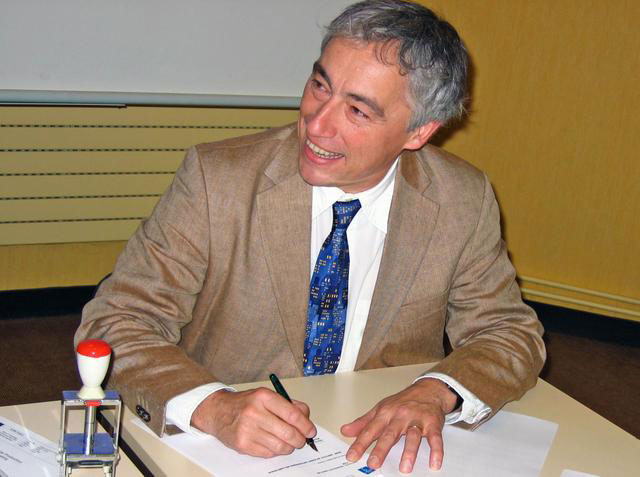
The ALMA Board has announced that Pierre Cox has been appointed as the next Director of ALMA, the Atacama Large Millimeter/submillimeter Array. Cox will take up duty on 1 April 2013, for a period of five years, at the end of Thijs de Graauw’s term as ALMA Director. Thijs de Graauw, who has been the ALMA Director since 2008, has taken the observatory past many milestones in his five-year term, including the start of its science observations, in 2011.
Additional information is available at http://www.nrao.edu/pr/2012/almadirector/
Upcoming Events
![]() The First Year of ALMA Science
The First Year of ALMA Science
Dec 12-15, 2012 | Puerto Varas, Chile
![]() ALMA Special Session
ALMA Special Session
Jan 8, 2013 | Long Beach, CA
![]() NRAO Town Hall
NRAO Town Hall
Jan 8, 2013 | Long Beach, CA
![]() NRAO CASA Tutorial
NRAO CASA Tutorial
Jan 9, 2013, 2:00 - 3:30 PT | Long Beach, CA
![]() ALMA Data Reduction Tutorial
ALMA Data Reduction Tutorial
Feb 28 - Mar 1, 2013 | Charlottesville, VA
![]() Transformational Science with ALMA: From Dust to Rocks to Planets
Transformational Science with ALMA: From Dust to Rocks to Planets
Apr 8-12, 2013 | Kona, Hawaii
![]() Radio Astronomy in the LSST Era
Radio Astronomy in the LSST Era
May 6 - 8, 2013 | Charlottesville, VA
Release of the Very Large Array Low-frequency Sky Survey Redux
Wendy Lane Peters (NRL), Bill Cotton (NRAO) and Namir Kassim (NRL)
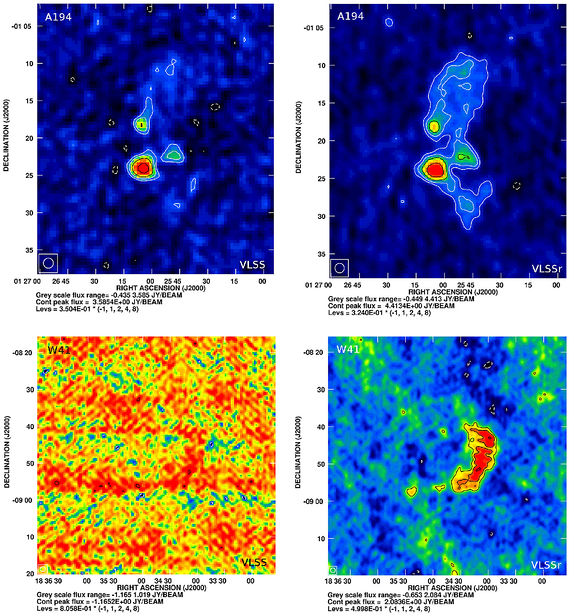
Comparison of the (left) VLSS and (right) VLSSr for two extended objects. (Top) Abell 194 is two luminous and distorted radio galaxies at the center of a low-redshift galaxy cluster. The improvement is due to a combination of increased extended source sensitivity and lower noise. (Bottom) W41 is a giant shell-type supernova remnant in the Milky Way. The improvement is due to the improved RFI suppression and the increased extended source sensitivity.
 Zoom
Zoom
The Naval Research Laboratory (NRL) and NRAO announce the release of the Very Large Array (VLA) Low-frequency Sky Survey Redux (VLSSr). We have completely re-imaged all data from the original VLSS survey.
The VLSSr covers the sky above declinations -30 deg at a frequency of 74 MHz with 75 arcsec resolution and an average rms noise of 0.1 Jy/beam. It includes six previously unpublished fields and improved dynamic range in 95% of all fields. The clean bias has been halved and is now 0.66x the local rms. The largest angular size imaged has been roughly doubled to 36 arcmin, and the number of cataloged sources is increased by 35% to 95,000.
Improvements made include application of a substantially more accurate primary beam correction, smart-windowing to reduce clean bias, and the use of new automatic radio frequency interference removal and bright-source peeling algorithms. We used the original VLSS as a starting sky model to enable higher-order Zernike fits to better model the ionospheric phase contributions.
Details of the improved reduction techniques can be found in W.M. Lane et al. (2012, Radio Science, 47, RS0K04) and a full description paper of the VLSSr is in preparation. Catalogs and images are on-line.
NRAO CASA Tutorial at Long Beach AAS
Carol Lonsdale and Gustaaf van Moorsel
NRAO will present a Splinter Session on the analysis of Jansky Very Large Array and ALMA data with the CASA software package at the 221st AAS meeting in Long Beach, California. No prior knowledge of CASA or radio interferometric data analysis is needed.
The presentations will provide an overview of the following topics suitable for novice VLA and ALMA users:
- Interferometry basics
- Introduction to the CASA package
- CASA data structures
- Basic VLA data reduction techniques
- Basic ALMA data reduction techniques
There will also be a question and answer session.
In addition, NRAO will host a small number of one-on-one sessions on CASA at the NRAO booth for investigators ready for a more detailed level of data reduction and analysis with CASA, including the opportunity to process data through a few reduction steps with expert guidance using one of our online VLA or ALMA tutorials. These approximately 30 to 45 min sessions will be scheduled by first-come, first-served sign-up at the NRAO booth in the main exhibit hall.
Participants should plan to bring their own laptop to take part in one of these sessions, with CASA V4.0 pre-installed and also a suitable tutorial dataset. For ALMA we recommend the NGC 3256 Band 3 dataset which can demonstrate all of ALMA's current capabilities.
For the VLA you have a choice of tutorial dataset depending on your interest. For those interested in Spectral Line data reduction, we recommend the tutorial
Carbon Star IRC+10216: high frequency (36GHz), spectral line data reduction
For those with specific questions about continuum polarization we recommend the tutorial Supernova Remnant 3C391: 6cm Polarimetry and Continuum Imaging,
Mosaicking, which consists of Part-1 and Part-2
If you have questions about reducing wide-band continuum data we recommend the tutorial Supernova SN2010FZ: Wide-band, narrow-field imaging; C-band (5-7 GHz).
In all three cases instructions about how to download the data can be found in the tutorial. Be sure to obtain the CASA V4.0 tutorial versions, which will be available shortly.
Community Day Applications Invited
Gustaaf Van Moorsel
NRAO New Mexico is pleased to receive applications from universities and other institutes in North America to host a Community Day, during which NRAO staff will present Very Large Array (VLA) observing from proposal to data reduction. The main goal is to introduce the vastly enhanced capabilities of the new VLA to those with some background in radio interferometry ahead of the Feb 2013 proposal deadline. We therefore anticipate the first series of these community days to take place during the remainder of 2012 and Jan 2013. Through hands-on tutorials we will cover the basics of proposing, scheduling block preparation, data retrieval, and CASA data reduction. If there is enough interest we will cover some aspects of Very Long Baseline Array (VLBA) observing as well.
There will be no cost to your institute; all we ask you to provide is:
(a) a minimum of 12 participants, each of which is expected to bring a modern laptop capable of running CASA (details to follow). To reach this minimum you could consider inviting colleagues from other institutes in your area. We strongly recommend each participant register at my.nrao.edu ahead of time.
(b) a sufficiently large meeting room with typical modern audiovisual capabilities (projector) and Wi-Fi.
To apply, and for any further information, please contact Emmanuel Momjian (emomjian at nrao.edu).
ALMA Project Status
Al Wootten
The Annual ALMA External Review took place in Santiago 22-25 Oct. The focus was on the end of ALMA construction. Most deliverables from the ALMA partners have been produced, packaged, and shipped to Chile.
In early Nov, the 23rd antenna from Vertex and the 12th from Alcatel arrived at the 16,000-foot elevation Array Operations Site (AOS), where there are currently 46 antennas of the final complement of 66. Fifty antennas have been accepted, outfitted, and tested and made the journey to the AOS. The 25th and final Vertex antenna is scheduled to undergo its acceptance procedures by ALMA within the next few days, completing the delivery of antennas from North America.
The final Front End assembly from the Front End Integration Center at the NRAO Technology Center in Charlottesville was shipped to Chile, bringing the assembly of those elements in North America to a close.
Commissioning continues, with a focus on Cycle 1 modes, such as 150 pointing mosaics; and on new equipment, such as the newly arrived antennas mentioned above, and on the newly completed four quadrant 64 station correlator. First fringes were obtained with the ALMA Band 5 receivers, which cover 163-211 GHz. Science targets in this band include the J=4-3 SiO maser (which was detected toward VY C Ma and W Hya), the low-energy water line at 183 GHz, and [C II] redshifted from early galaxies at z~10. An early complement of six of these receivers was provided to ALMA through a project funded by the European Union.
This Month @ the NAASC
Al Wootten
ALMA Cycle 1 Proposals Status
Technical assessment of the ALMA Cycle 1 proposals was completed for those proposals that received the highest scores from the proposal review committees. A list of highly ranked proposals was forwarded to the ALMA Director's Council for concurrence. Notices will be sent to successful Principal Investigators the week of 12 Nov. Also that week, the ALMA Board will meet in Santiago.
ALMA Cycle 0 Data Status
ALMA Early Science Cycle 0 observations have begun once more after the September shutdown, during which the correlator was upgraded to its final four quadrant configuration.
Since the beginning of October there were 14 datasets delivered to North American principal investigators. We expect results from many of these to figure among the fifty projects from ALMA Cycle 0 data for which abstracts were submitted for the meeting 'The First Year of ALMA Science' to be held in Chile 12-15 December. There were also 26 abstracts submitted on ALMA Science Verification data among the total of 138 abstracts submitted. The Science Organizing Committee is now going through the selection and scheduling process.
ALMA Data Reduction Tutorial
The NRAO North American ALMA Science Center is offering a two-day ALMA Data Reduction workshop at NRAO Headquarters in Charlottesville, Virginia, on 28 February and 1 March 2013. The aim of this workshop is to assist interested observers in learning how to reprocess their ALMA data, and to allow new and potential users to become familiar with the data format and the tools available. During the workshop, there will be presentations by local staff covering CASA and the basics of mm/submm interferometry, and participants will gain hands-on training using a recent ALMA dataset from the Science Verification program.
There will be a total of 30 desktops allowing at most 30 participants, so early registration is important. Further information, as well as a preliminary program and registration form, will be available soon at https://science.nrao.edu/facilities/alma.
First Year of ALMA Science
The First Year of ALMA Science Workshop will take place in Puerto Varas, Chile, 12-15 Dec 2012. ALMA Early Science operations began at the end of Sep 2011. Over one hundred high science profile projects have been identified as high priority for execution. The first exciting scientific results from Science Verification datasets and Cycle 0 observations are coming out in refereed journals since the beginning of 2012. At the end of the year, the ALMA users community will be in a position to review the first science results produced by this new and unique facility. The conference will cover all the ALMA Science topics covered by Early Science observations, from observations of the Solar System bodies to objects in our own Galaxy, the local to high redshift Universe. While the conference will be focused on ALMA observational results, we plan to include presentations and discussions on related theoretical implications and predictions as well as relevant complementary data from other major facilities. The conference will also be an ideal venue to discuss the scientific priorities for the ALMA development plan upgrades in the context of the first results from Early Science.
New Science Verification Data Portal
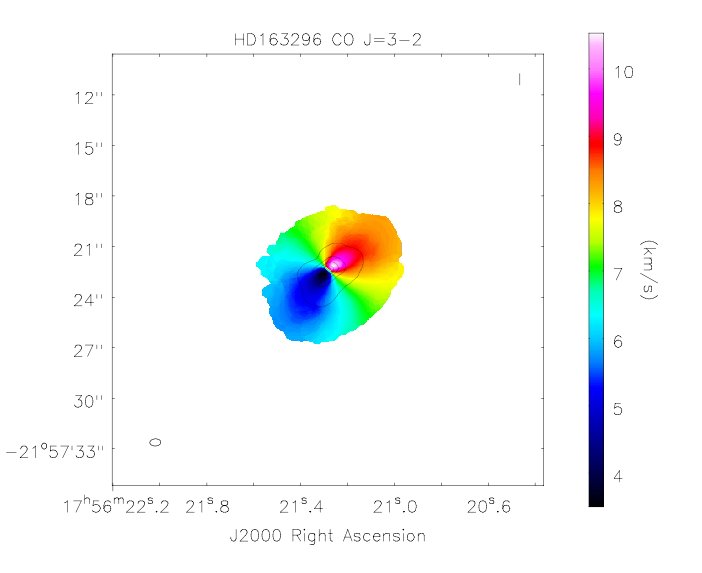
The rotating circumstellar disk around the Herbig Ae star HD163296, observed in the J=3-2 line of CO by ALMA. The contours outline the first moment intensity map of the emission.
 Zoom
Zoom
A new installment of Science Verification data is available. This release contains three new datasets corresponding to targets suggested by the community and listed on the Science Verification web page:
- The protoplanetary disk HD163296: this nearby (122 pc) 900 AU circumstellar disk around the Herbig Ae star HD163296 was imaged at high spectral resolution by ALMA in the lines of several isotopes of CO (λ~1.3mm), and of the main isotope of CO (λ~0.87mm), demonstrating the mixed modes capability at Bands 6 and 7.
- The Galactic Centre, Sgr A*: recombination lines at Band 3
The Science Verification data sets are available through the ALMA Science Portal at ALMA Data. The data products released here contain raw, uncalibrated data to allow users to try their hands at a complete data reduction process. A calibrated data set is also provided, allowing users to perform data analysis and post-processing, as well as reference images generated from the reduced data sets. There are data reduction suggestions for these datasets provided in the form of a script, as well as additional information about the dataset in a README file.
We hope that you will find that the quality of these datasets is impressive, but please remember that ALMA is still in the construction phase, and we are continuously testing new observing modes. These observations are made using new equipment and software and thus may contain more idiosyncrasies than data released to PIs in Early Science.
We thank the large number of staff at the JAO and the ARCs who have participated in the commissioning activities, observations and data reduction that made this release possible.
Reminder: In order to reduce and/or analyze the ALMA data, users need to use the Common Astronomy Software Applications (CASA) package. The CASA package can be accessed through http://casa.nrao.edu. The CASA Guide requires the CASA 3.4 version. Feedback on the data and on the CASA software is always welcome!
A Digital Highway to ALMA
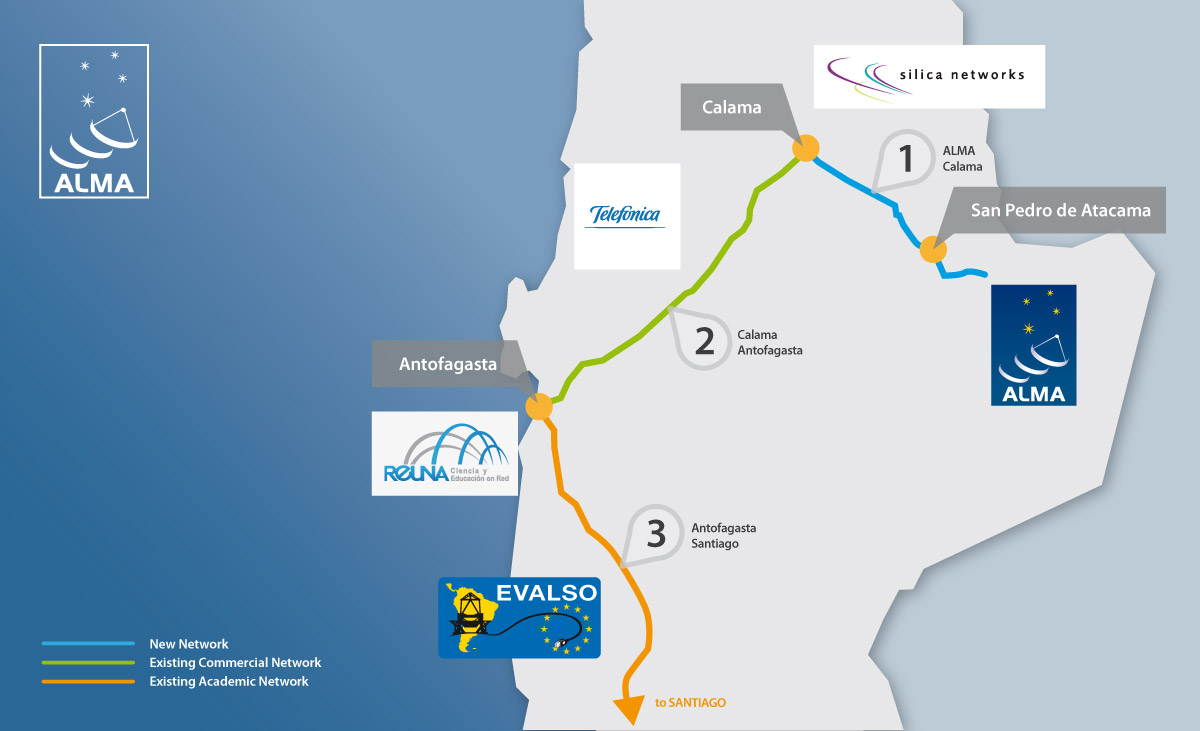
 Zoom
Zoom
Associated Universities, Inc. has signed a contract on behalf of ALMA with two Chilean companies -- Silica Networks Chile S.A. and Telefónica Empresas Chile S.A -- to immediately begin construction on ~150 kilometers of fiber optic cable between Calama and the ALMA site, located 34 kilometers from San Pedro de Atacama. From Calama, the network will connect to existing infrastructure to Santiago and the world. As a result, ALMA will increase its data transmission capacity by more than 25 times. The project is funded under the ALMA Development program.
"This long-term structural solution not only has the advantage of being able to convey more data, it could also allow us to operate some of the observatory activities from Santiago", says Jorge Ibsen, Head of ALMA Department of Computing.
ALMA's digital highway will be operational in 2014. Currently, data is transferred via microwave link from the remote and hostile desert to the ALMA archives in Santiago, Charlottesville, Garching, and Mitaka. The new route will enable the transfer of the enormous quantity of data that ALMA will produce when fully built. The route operates bi-directionally and will also improve communication between the ALMA centers and those operating the Joint ALMA Observatory (JAO) in Chile. The new route will facilitate the transfer of the enormous quantity of data that ALMA is capable of producing when fully built, boosting ALMA's scientific capability.
Meet the NAASC
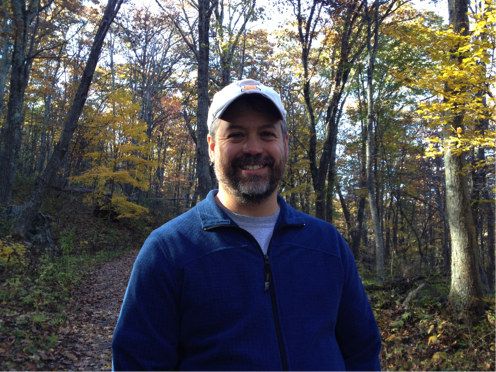
Leslie Looney
 Zoom
Zoom
Leslie Looney
Leslie Looney came to the North American ALMA Science Center (NAASC) as a sabbatical visitor in July 2012 and will be staying until July 2013. Leslie is an Associate Professor of Astronomy at the University of Illinois. Leslie did his PhD at University of Maryland (graduating in 1998) working with Lee Mundy and the Berkeley Illinois Maryland Association (BIMA) array group. Leslie focused his dissertation on high-resolution, dust continuum imaging at 3mm of young protostars. After leaving Maryland, Leslie moved to the Max Planck Institute for Extraterrestrial Physics in Garching, Germany as the Project Scientist for developing the far-infrared integral field spectrometer FIFI LS for SOFIA. Leslie joined the faculty of the University of Illinois in 2003, working on a range of star formation projects using primarily the Combined Array for Research in Millimeter-wave Astronomy (CARMA). In 2010, he became the Director of the Laboratory for Astronomical Imaging (LAI) at Illinois. The LAI's main role is operation of the CARMA data archive and data reduction pipeline development. Also in 2010, Leslie joined the ALMA North American Science Advisory Committee, a key motivation for his choice of the NAASC for his sabbatical visit.
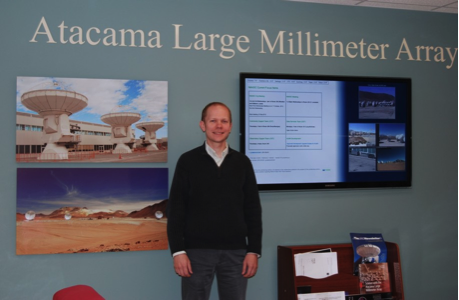
Paul Martini
 Zoom
Zoom
Paul Martini
Paul Martini joined the NAASC as a Sabbatical Visitor on 1 Aug 2012. Paul is an Associate Professor in the Astronomy Department at Ohio State University, where he conducts research on many extragalactic topics, teaches undergraduate and graduate students, and builds instruments for ground-based visible and near-infrared telescopes. Paul obtained his Ph.D. in Astronomy from Ohio State, spent three years as a Carnegie Fellow in Pasadena, and then two years as a Clay Fellow at the CfA before moving back to Ohio State. His recent research has focused on the evolution of star formation and active black holes in clusters of galaxies, the efficiency of star formation in late-type galaxies, and the lifetime and fueling processes of Active Galactic Nuclei. Paul has also worked on a number of instruments, including the Ohio State Multi-Object Spectrograph (OSMOS) at the 2.4m MDM Hiltner telescope, and he is presently building the KOSMOS and COSMOS instruments for Kitt Peak and CTIO in collaboration with the National Optical Astronomical Observatory.
Paul moved to Charlottesville for the year because he plans to incorporate more radio data, most notably from ALMA and the VLA, into the mostly visible, infrared, and X-ray data he has worked with to date. He hopes to better understand the cold ISM in nearby, early-type galaxies, investigate star formation in galaxy disks, study the high-redshift QSOs that he plans to identify with the Dark Energy Survey, measure the evolution of the cold ISM content of cluster galaxies, and probe the low-luminosity end of the FRII luminosity function. He also plans to develop and teach a course on radio astronomy upon his return to Ohio State.
2013 Rocks! Abstract Submission

The North American ALMA Science Center (NAASC), in cooperation with the Academia Sinica Institute of Astronomy and Astrophysics (ASIAA) in Taiwan, is pleased to announce the 7th NAASC workshop entitled: “Transformational Science with ALMA: From Dust to Rocks to Planets – the Formation and Evolution of Planetary Systems." This NAASC-ASIAA "2013 Rocks!" workshop will be held 8-12 Apr 2013 on the Big Island of Hawaii.
2013 Rocks! is accepting abstracts until 31 Dec.
Make sure you visit the meeting website for all relevant meeting information including links to the preregistration and abstract submission. Also, like us on Facebook to receive the most recent updates and announcements posted by the meeting organizers and your colleagues.
2013 Rocks! is committed to broadening participation by women and under-represented minorities.
Molecular Spectroscopy in the Era of Far-IR Astronomy
Seventy-two astrophysicists and chemists met at Emory University 29-31 Oct to discuss needs from lab astrophysics in the coming years, with a focus on Far-IR spectroscopy. The needs will be summarized and highlighted in a white paper that will be written over the coming months which can inform decisions on future inquiry and action.
Both in laboratory and at the telescope, scientists must cope with the increasing size of datasets which are produced; these large datasets need new tools for proper assessment of their content. One must be able to model molecules with many atoms and to acquire spectra with good sensitivity at reasonable speed for comparison to the models. To understand the excitation of the molecules, collisional and radiative rates are needed and provide a crucial tool for interpretation. Herschel has highlighted the needs in the far infrared, an area which will be explored further by ALMA, SOFIA, CCAT and JWST. The challenges posed by new data in this little-explored wavelength range require good collaboration among groups, with good dissemination of information. Critically, the next generation of spectroscopists and astrochemists need to be trained, welcomed and retained in the field.
Third VLA Data Reduction Workshop
Gustaaf van Moorsel
NRAO is pleased to announce the third Very Large Array (VLA) Data Reduction Workshop, which will take place 8 - 12 April 2013 at the Pete V. Domenici Science Operations Center in Socorro, NM. The aim of the workshop is to assist observers with the challenges posed by the increased flexibility and complexity of the VLA. The focus will be on reducing data taken in the wide-band WIDAR modes that have been available to the observing community since 30 Sep 2011.
During the workshop observers will be able to reduce their own data using hardware provided by NRAO and with NRAO staff experts present for consultation. There will also be presentations by local staff covering the Common Astronomy Software Applications (CASA) package and the very latest developments in data reduction techniques.
This is an advanced workshop, and unlike our Synthesis Imaging summer schools, not intended for those who are new to radio interferometry. Prior experience with the Astronomical Image Processing System (AIPS), CASA, or the Multichannel Image Reconstruction Image Analysis and Display (MIRIAD) package is required. As we will be using CASA as our main data reduction package, a working knowledge of it would be helpful: we strongly recommend those new to CASA to go through one or more of our online tutorials prior to attending the workshop.
There will be a total of 30 desktops available during the workshop, thus allowing a maximum of 30 participants. In a few cases, two people working on the same data may share a machine; this can be requested during registration. To register please visit the workshop website.
CASA Release 4.0.0 Available
Juergen Ott and the CASA team
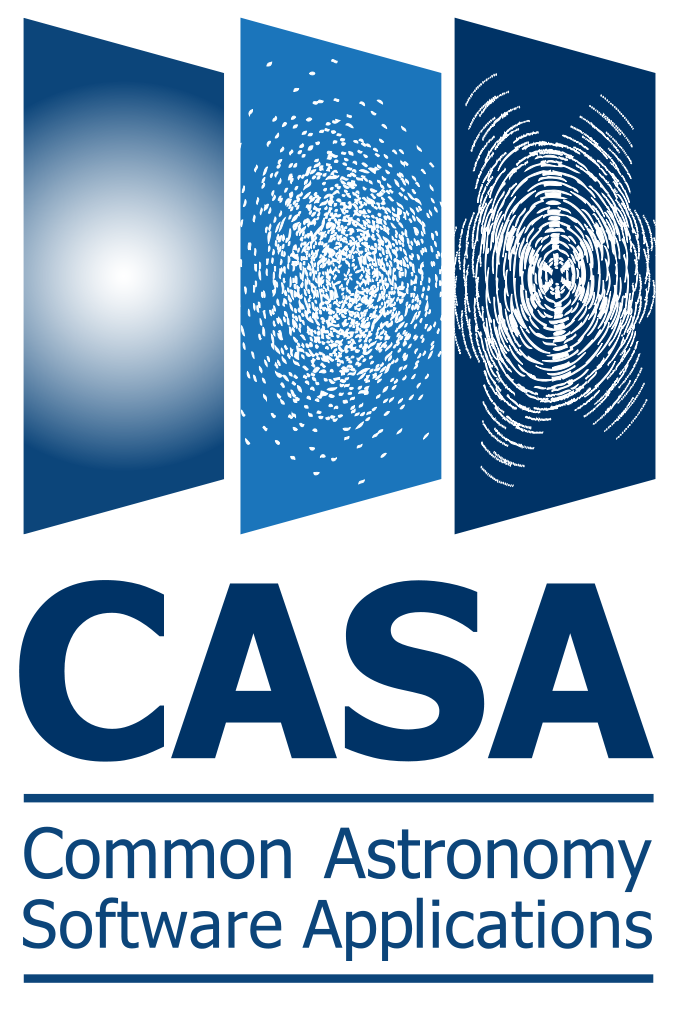
We are pleased to announce a new release of the Common Astronomy Software Applications (CASA) package (4.0.0). CASA is being developed by NRAO, ESO, and NAOJ and is used for the offline reduction and analysis of both Atacama Large Millimeter/submillimeter Array (ALMA) and Karl G. Jansky Very Large Array (VLA) data. CASA is fully scriptable. Full support is provided for ALMA, VLA, and Jansky VLA formats, but almost any data that can be written in uvfits format can be imported and reduced in CASA, including the Combined Array for Research in Millimeter Astronomy (CARMA), the Submillimeter Array (SMA), and the Australia Telescope Compact Array (ATCA).
Linux and MacOS distributions of CASA 4.0.0 are now available from the CASA webpage. Please follow the links to Obtaining CASA.
We have changed the supported Operating Systems to include:
- Linux (64bit): RedHat 5.7 & 5.8
- Mac OS: 10.6 (Snow Leopard), 10.7 (Lion)
This is the last CASA release to support Mac OS 10.6. We will transition to support for Mac OS 10.7 (Lion) and 10.8 (Mountain Lion) with all future releases
New features in CASA 4.0.0 include:
- For large fractional bandwidths, clean will now use per-channel restoring beams and all analysis tasks support this format
- Support for calibration of linear polarization feeds
- Improved parallel clean functionality and interface
- Updated models in setjy
- Substantial improvements to the spectral viewer, including fitting, labeling, and moment creation
- tflagdata is now flagdata and the older flagging task versions are obsolete
- Single dish OTF map calibration can now use the edge of the map as a reference
A full list of new features in CASA 4.0.0 is available with the release notes. We also encourage you to subscribe to the following mail lists:
- Casa-announce for announcement of new releases, workshops, etc.; and
- Casa-users for critical bugs and code updates.
If you have any questions, please consult the NRAO helpdesk for all VLA – VLBA – GBT related questions; ALMA-related questions should be directed to the ALMA helpdesk .
Radio Astronomy in the LSST Era
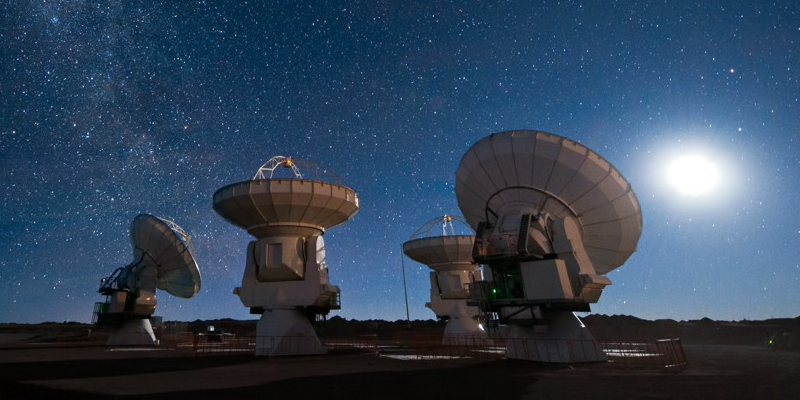
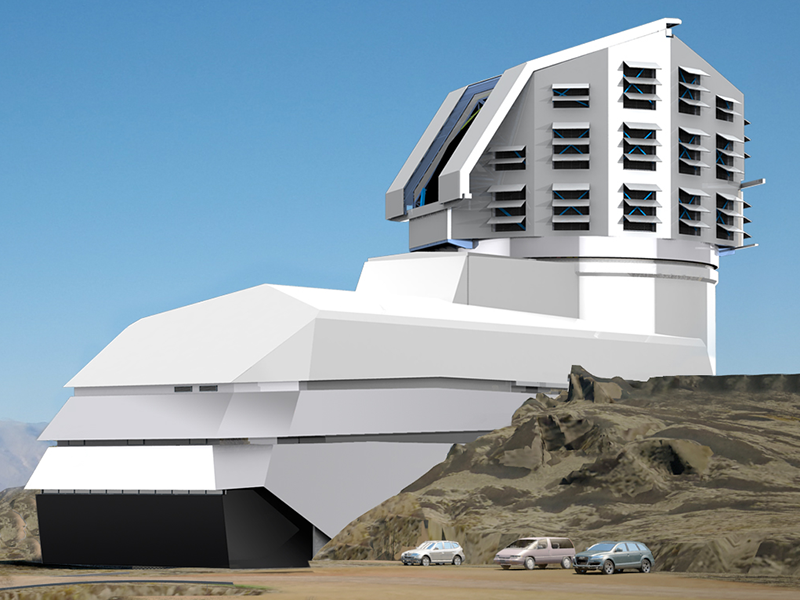
 Zoom
Zoom
Scientific Organizing Committee (SOC) J. Lazio (Chair), R. Dickman, S. Dougherty, Z. Ivezic, N. Kassim, K. Kellermann, A. Kimball, S. Myers, A. Soderberg
NRAO will host a 2 ½ day workshop to explore the landscape of radio wavelength observations in an era in which the Large Synoptic Survey Telescope (LSST) is producing thousands of nightly alerts and developing a deep, multi-color view of the sky. Radio wavelength observations will provide independent, complementary views of the sky, and they will be crucial for full exploitation of the LSST data products. The workshop will be structured around the science themes of time domain radio astronomy and radio complements to multi-wavelength sky surveys, leading to the identification of emerging scientific and technical capabilities needed for conducting observations in these areas. The workshop will be focused around invited talks covering key areas, but there will also be ample opportunity for contributed talks, posters, and discussion. A goal of the workshop is to produce a community document summarizing the outcomes, the range of observations, and needed capabilities.
The workshop will be held in Charlottesville, Virginia 6 – 8 May 2013. Speakers confirmed to date, and their topics for discussion include:
| A. Baker | Rutgers | Deep Views of Galaxies |
| A. Barger | Wisconsin | Multi-wavelength Sky Surveys |
| N. Brandt | PSU | Multi-wavelength Galaxy Evolution |
| T.-C. Chang | ASIAA & NRAO | Cosmology from Sky Surveys |
| S. Chatterjee | Cornell | Radio Selected Transients |
| T. Clarke | NRL | Cosmic Magnetic Fields |
| J. Condon | NRAO | Extragalactic Source Populations |
| G. Hallinan | Caltech | Stars and Sub-Stellar Objects |
| M. Huynh | UWA & SKA Office | Beyond the Current Generation of Surveys |
| M. Jarvis | Oxford | Evolutionary Map of the Universe |
| M. Juric | LSST | Data Management in Large Surveys |
| C. Lang | Iowa | Observing the Galaxy |
| S. Nissanke | Caltech | Electromagnetic Counterparts to Gravitational Waves |
| R. Osten | STScI | Multi-Wavelength Stars |
| M. Strauss | Princeton | Surveys With LSST |
| T. Tyson | UC Davis | LSST Overview |
| B. Zauderer | CfA | Radio Follow-up of Multi-Wavelength Transients |
More information is available on the conference web site.
Career Opportunities
New Postings
Co-op Student: The National Radio Astronomy Observatory in Socorro, NM is seeking a Co-op to perform RFI and EMC testing at the Very Large Array. The tasks will include the collection, analysis and presentation of monitoring system data, the location, identification and mitigation of detected RFI, and performing RF power measurements in a RF reverberation chamber. This is a temporary full time assignment up to six months.
Public Education Specialist: The National Radio Astronomy Observatory in Green Bank, WV is accepting applications for a Public Education Specialist. The Education Specialist leads, develops, and actively participates in the K-12 education, public outreach, and visitor center programs. In addition, the Education Specialist collaborates with the Green Bank Education Officer, the Assistant Director for Education and Public Outreach (EPO) and all EPO staff to design, fund, implement the Observatory-wide formal and informal education program.
Electronics Engineer II: The National Radio Astronomy Observatory in Socorro, NM is recruiting for a Electronics Engineer to carry out and assist in engineering analysis, design, and general prosecution of a project or whole system. The responsibilities of the Electronics Engineer will include recommendations, coordination and assist in decisions on such aspects as design, procurement, manufacture, erection, test and some degree of initial operation.
Systems Administrator I: The National Radio Astronomy Observatory in Socorro, NM is invites applications for a Systems Administrator. This position will support local technical and scientific staff Redhat Linux systems and assist in the development and maintenance of the EVLA and VLBA data archive, high performance computing systems.
ALMA Control System Java Developer: The NRAO in Socorro, NM is recruiting for an ALMA Control System Java Developer. The primary responsibility of this position is to maintain the high level layer of the Control subsystem, extending and improving the existing code, and debugging the problems found during operations.
Business Systems Analyst: The NRAO in Charlottesville, VA is accepting applications for a Business Systems Analyst. The incumbent will support observatory-wide operations by leveraging information technology resources to provide insight, analysis and strategy regarding financial position, have proven experience in the field of systems and business analysis and a strong and exceptional working knowledge of Microsoft Excel and Access applications, VBA and ERP systems.
NAASC Postdoctoral Fellow: The NRAO in Charlottesville, VA invites applications for a postdoctoral fellow to work with the North American ALMA Science Center (NAASC) scientific staff. Applicants for this position should expect to spend 50% of their time on independent research, with the remaining time spent on developing ALMA expertise and assisting the NAASC scientific staff in the support of ALMA users.
Public Information Officer: The NRAO in Charlottesville, VA invites applications for a Public Information Officer. He/she will be responsible for duties related to media relations, publicity, and, as directed, community relations, principally for the NRAO's newest telescope, the Atacama Large Millimeter/sub millimeter Array (ALMA). The Public Information Officer will be designated point of contact for inquiries and contacts with news media, the general public, community organizations, and other science research institutions with which NRAO may seek to generate joint publicity.
From the Archives
Ellen Bouton

About this month's photo: A Century-Old Piece of the Very Large Array (VLA): The rail system of the VLA, used to transport the 230-ton antennas, was built in the 1970s using rails and ties salvaged from railroads that were going out of business. Many of the steel rails are marked with their year of manufacture. At least one of those rails now has reached centenarian status. This rail, on the VLA West Arm, was manufactured in 1912, the same year that New Mexico achieved statehood. The state-of-the-art technology brought by the VLA expansion now works alongside a 100-year-old, functioning component to provide cutting-edge research capabilities!
Photo by Dave Finley, NRAO/AUI/NSF.
Correction to November 2012 From the Archives caption: The piers on which Bracewell asked astronomers to chisel their signatures were those of the 32-element solar cross (Heliopolis), not those of the 5-element array. Thanks to George Downs for pointing out the error.
From the Archives is an ongoing series illustrating NRAO and U.S. radio astronomy history via images selected from our collections of individuals' and institutional papers. If readers have images they believe would be of interest to the Archives, please contact Ellen Bouton, ebouton@nrao.edu.

